
The National Weather Service’s Space Weather Prediction Center (SWPC) says, “The geomagnetic field is expected to be quiet to unsettled (today) under continued, but weakening, negative polarity CH HSS influence.
Dark regions on the Sun known as coronal holes are one of the main drivers of space weather now.According to the Space Weather Prediction Center, coronal holes appear as dark regions on the Sun because they are cooler than the surrounding plasma and are open magnetic field lines.
Solar wind is always flowing from the Sun and towards Earth but coronal holes are known for releasing enhanced solar wind.Coronal holes can develop anywhere on the sun and are more common during solar minimum.
Normally, coronal holes located near the Sun’s equator, result in faster solar wind arriving at Earth.
It is common to see coronal holes produce G1-G2 geomagnetic storming levels and sometimes on rare occasions, upwards to G3 levels have been met.
If Earth is experiencing the effects of a coronal hole and a coronal mass ejection is forecasted to impact Earth, the combined effects could result in a more significant impact and more intense geomagnetic storming.
Analyzing data from the DSCOVER and ACE satellite is one way forecasters can tell when the enhanced solar wind from a coronal hole is about to arrive at Earth.
While typically known for their weather forecasts, the National Oceanic and Atmospheric Administration (NOAA) and its National Weather Service (NWS) is also responsible for “space weather.” While there are private companies and other agencies that monitor and forecast space weather, the official source for alerts and warnings of the space environment is the Space Weather Prediction Center (SWPC)The Space Weather Prediction Center is also one of nine National Centers for Environmental Prediction (NCEP) as they monitor current space weather activity 24/7, 365 days a year
